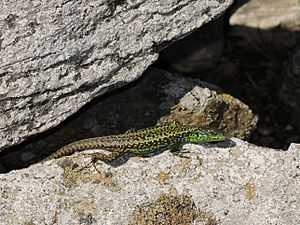Leonese rock lizard facts for kids
The Leonese rock lizard (Iberolacerta galani), also known as Galan's rock lizard, is a type of lizard. It belongs to the family called Lacertidae. This special lizard lives only in Spain.
Quick facts for kids Leonese rock lizard |
|
|---|---|
 |
|
| Conservation status | |
| Scientific classification | |
| Genus: |
Iberolacerta
|
| Species: |
galani
|
 |
|
| Distribution of the Leonese rock lizard. | |
Contents
Where Does It Live?
The Leonese rock lizard, or Iberolacerta galani, lives only in one specific area. It is found in the Montes de León mountains. These mountains are located in the northwestern part of Spain. When an animal or plant lives only in one place, it is called endemic.
How It Got Its Name
The scientific name for this lizard is galani. This name was chosen to honor a scientist named Dr. Pedro Galán Regalado. He was a Corunnan herpetologist. A herpetologist is a scientist who studies reptiles and amphibians. Dr. Galán spent his life studying the reptiles and amphibians of the Iberian Peninsula. He also studied nature in general.
What Does It Look Like?
The Leonese rock lizard is quite large for its kind. It is the biggest species in the Iberolacerta group. Female lizards can grow up to 84 mm (3.3 in) long. This measurement is from their snout (nose) to their vent (a small opening near the tail).
This lizard also has some special features. It often has many blue spots on its shoulders. These spots are called ocelli. Another unique feature is how its scales are arranged on its head. The scales above its nose (supranasal scales) often touch or are very close to the first scales on its snout (loreal scales).
Where Does It Live?
The Leonese rock lizard likes to live in rocky areas. These areas are usually above the tree line in mountains. This means they live where trees do not grow anymore. Their homes are found at heights between 1,000–2,000 m (3,300–6,600 ft). The climate in these places is a high-mountain climate. This means it can be quite cold and harsh.
Reproduction
The Leonese rock lizard reproduces by laying eggs. This way of reproducing is called oviparous.
See also
 In Spanish: Lagartija leonesa para niños
In Spanish: Lagartija leonesa para niños


